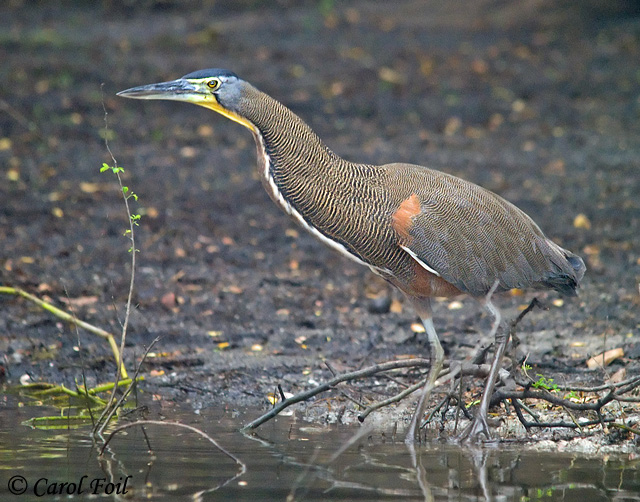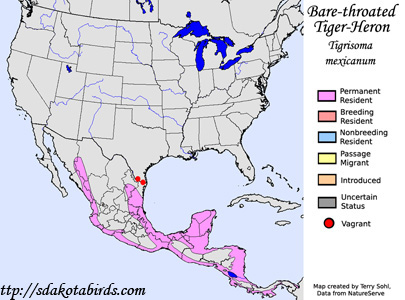| Length: 28 - 32 inches | Wingspan: 45 inches | Seasonality: Non-resident in South Dakota |
| ID Keys: Brownish back and neck with thin dark striping, dark crown and nape, featherless yellow throat, gray face with yellow around yellow eyes, | ||
 The
Bare-throated Tiger-Heron is a rather large heron species found in much of
Mexico and Central America. In the United States, they are only known
from a single sighting, in southern Texas very near the Mexican border.
They are named for the patch of bare yellow skin on the throat. They
are most active near sunrise or sunset, and may also be actively foraging at
night.
The
Bare-throated Tiger-Heron is a rather large heron species found in much of
Mexico and Central America. In the United States, they are only known
from a single sighting, in southern Texas very near the Mexican border.
They are named for the patch of bare yellow skin on the throat. They
are most active near sunrise or sunset, and may also be actively foraging at
night.
Habitat: Found in a variety of wetland habitats, both freshwater and saltwater. Along the coasts, they can be found in mangrove swamps. In the interior, they will utilize freshwater marshes and forested wetlands.
Diet: Feeds on fish, amphibians, crustaceans, and other vertebrates. Will also consume large insects.
Behavior: Often feeds by waiting motionless in shallow water, waiting for prey to approach. When prey is within range, it is captured with a quick thrust of the neck. They will also very slowly walk through the shallows in search of food.
Nesting: The nest is a large platform of sticks, lined with leaves or other softer vegetative material. It is usually placed in a tree that overhangs or is near water. The female lays between 1 and 3 eggs.
Interactive eBird Map: Click to access an interactive eBird map of Bare-throated Tiger Heron sightings
Song: Has multiple vocalizations. During the breeding season, often gives a repeating, carrying orrr-orrr-orrr-orrr. When disturbed, they give a repeating howk-howk-howk call.
Migration: Considered a permanent resident throughout its normal range.
Similar Species: Not likely to be confused with other heron species normally found in the United States.
Conservation Status: Populations are thought to be generally stable, they are found over a relatively wide geographic area, and are relatively common in some areas. The IUCN lists the Bare-throated Tiger-Heron as a species of "Least Concern".
Further Information: 1) BirdLife International - Bare-throated Tiger-Heron
2) HeronConservation.org - Bare-throated Tiger-Heron
3) DiscoverLife.org - Bare-throated Tiger-Heron
Photo Information: Photo taken by Carol Foil - March 7th, 2011 in Belize - Photo licensed under Creative Commons Attribution NonCommercial NoDerivs 2.0 Generic License
| Click below for a higher-resolution map |
 |
| South Dakota Status: Non-resident in South Dakota |
Additional Bare-throated Tiger-Heron Photos (coming soon!!)
